|
Steve Ditko,
1927 - 2018
The
Uncompromised
STEVE DITKO,
DUBBED THE J.D. SALINGER OF COMICS, who has not been seen or heard in public
for 50 years, died as obscurely as he lived. They found his body in his
Manhattan apartment on June 29, but authorities said he’d been dead for a
couple of days. He was 90. He’d left Marvel and the iconic characters he
created there when he was 39.
Ditko,
along with the artist Jack Kirby and the writer and editor Stan Lee, was a central player in a seminal period in the history of comic books— the
1960s cultural phenomenon of creating the Marvel Universe, whose characters
today are ubiquitous in films, television shows and merchandise.
"Comics
are unimaginable without his influence," tweeted Patch Zircher, a
comic-book artist who has worked on Batman and Superman for DC Comics. "He
co-created Spider-man, which will be remembered as significant as Doyle
creating Sherlock Holmes or Fleming creating James Bond. Spider-man may outlast
them both."
One
of the most popular superheroes ever conceived, said Ellis Clompton at
variety.com, Spider-Man generated over 360 million book sales total since his
debut in 1962.
"Thank
you Steve Ditko, for making my childhood weirder," fantasy and graphic
novel author Neil Gaiman said in a series of tweets to his 2.7 million
followers. "He saw things his own way, and he gave us ways of seeing that
were unique. Often copied. Never equaled. I know I'm a different person because
he was in the world."
Edgar
Wright, director of movies including "Baby Driver" and "Shaun of
the Dead," said on Twitter that Ditko was "influential on countless
planes of existence."
English
TV and radio host and comic books super-fan Jonathan Martin tweeted that Ditko
was "the single greatest comic book artist and creator who ever
lived."
The
best—most extensive and detailed—treatments of Ditko’s life and work are Andy
Webster’s obit for the New York Times (to which Sandra W. Garcia
contributed) and Michael Dean’s for the Comics Journal at tcj.com; Dean
offers the most detailed bibliographic account. I’ll be using Webster’s article
as the basis for my appreciation of Ditko, adding (in italics when not
otherwise indicated) scraps and squips from other obituaries and my own
comments. But I’ll begin with Dean’s opening—:
Stan
Lee, in his credits for The Amazing Spider-Man, called the artist
“Swingin’ Steve Ditko” (issue No.10) and later “Scowlin’ Steve Ditko” (issue
No.27), but if you had to choose one adjective to attach to Ditko’s name, it
might be “Uncompromising.”
Consider
these facts:
■
At a time when Marvel cultivated a house look based on Jack Kirby’s muscular
explosiveness, Ditko stuck to his own style — all rubbery sinews and urban
shadows. In an extreme version of the famous Marvel Method, Ditko said he told
the stories visually, often with little or no input, inventing villains and
situations, which Lee retroactively scripted. When communications broke down
between the artist and writer, Ditko simply walked away without explanation.
■
Ditko’s independent Mr. A comics for Wally Wood’s witzend magazine in 1967 expressed his objectivist philosophies in bluntly abstract
scenarios, even though they had little appeal for most young comics readers and
were out of sync with countercultural ideologies of the time. He continued to
draw Mr. A for more than 50 years.
■
When Renegade Press publisher Deni Loubert accepted an Inkpot Award on
Ditko’s behalf at the 1987 San Diego Comic-Con, Ditko was reportedly outraged
and insisted that she return it.
■
Plans for a late 1990s comics series to be written and drawn by Ditko and
published by Fantagraphics were scuttled after the first issue when Ditko took
offense at a coloring mistake on the cover. Offers to make amends by printing
the art with the correct coloring in a later issue were rejected by Ditko, who
refused to do any further issues.
■
In 2007, a BBC documentary, “In Search of Steve Ditko,” tracked Ditko down to
his New York apartment but could not coax him to appear on camera or be
interviewed. Although Spider-Man co-creator Lee made a career of being in the
public eye, Ditko gave no interviews after 1968, turning down even a request
from his hero, Will Eisner.
■
He declined to cooperate with Blake Bell’s 2008 Ditko biography Strange
and Stranger: The World of Steve Ditko, calling the book, sight unseen, a
“poison sandwich,” and turned the biographer away from his door, as he had many
journalists over the years.
■
When prominent novelist Jonathan Lethem asked to include a Ditko story in the
2015 volume of The Best American Comics, Ditko turned him down.
■
Despite living a Spartan existence eking out a meager living his final years,
he refused to sell his original art, which would have been worth hundreds of
thousands of dollars. Small-press publisher Greg Theakston told of
finding the artist using original Ditko art from 1958 as a cutting board.
Some
of the mysteries about Steve Ditko we’ll try to sort out as we next wander through
Webster’s New York Times article; the rest, alas, will be buried with
the artist.
THOUGH DITKO
HAD A HAND in the early development of other signature Marvel characters —
especially the sorcerer Dr. Strange — Spider-Man was his definitive character,
and for many fans he was Spider-Man’s definitive interpreter. Ditko was noted
for his cinematic storytelling, his occasional flights into almost psychedelic
abstraction, and the philosophical convictions that often colored his work.
Scrupulously private, he had a mystique rare among industry superstars.
The
initial visual conception of Spider-Man did not come from Ditko. According to
Bell, that image came from Kirby, who penciled an origin story for the Marvel
title Amazing Fantasy in 1962 (although Kirby’s Spider-Man was much
too muscular for the incipient teenage superhero).
Writing
in Robin Snyder’s The Comics, a "first-person history"
newsletter of comics, Ditko gives his version of the story—:
"For
me, the Spider-Man saga began when Stan called me into his office and told me I
would be inking Jack Kirby's pencils on a new Marvel hero, Spider-Man. I still
don't know whose idea was Spider-Man."
Ditko
refers to Lee's interview of a previous year on "Larry King Live"
during which King reminded us of Lee's claim that he started thinking of a
spider when he saw a fly on the wall.
"You
know," Lee said, "I've been saying it so often, for all I know it
might be true." (Later in that interview, by the way, Lee insists that he
was always assisted in the creation of Marvel heroes by the artists he worked
with; but “always” wasn’t true in the early years of Marvel’s ballooning
popularity when Lee was repeatedly interviewed by reporters.)
Ditko
continues: "A leap from a fly to a spider is like from man to a cannibal.
Stan never told me who came up with the idea for Spider-Man or for the
Spider-Man story that Kirby was pencilling. Stan did tell me Spider-Man was a
teenager who had a magic ring that transformed him into an adult hero —
Spider-Man. I told Stan it sounded like Joe Simon's character, The Fly
(1959), that Kirby had some hand in, for Archie Comics. Now here is a
fly-spider connection. ... Stan phoned Kirby about The Fly; I don't know what
was said in that call."
Later,
the Kirby-pencilled pages were discarded— and so were the magic ring idea and
the notion that Spider-Man would be an adult. Had the original plan been
followed— if Ditko had said nothing about The Fly— what sort of Spider-Man
might have emerged, Ditko asks. Then answers:
"There
would be lots of nots: Not my web-designed costume, not a full
mask, no web-shooters, no spider-senses, no spider-like
action, poses, fighting style and page breakdowns, etc." As far as I'm
concerned, Ditko has made his case: he had more to do with the creation of Spider-Man
than anyone else.
DITKO RAN WITH
THE CHARACTER (Webster takes up the story again). Spider-Man made his debut
that year (1962) in Amazing Fantasy No.15, and the character’s
popularity led to his own title, The Amazing Spider-Man, which Ditko penciled,
inked and largely plotted from 1963 to 1966. He began to get a credit-line
for plotting with No.25. But Stan Lee, the public face of Marvel Comics, often
took all the credit in the early days of the Marvel revival of the industry.
Not
to fault Lee. As I mentioned a couple paragraphs ago, the people he told that
he created Spider-Man were newspaper and magazine reporters, and in those early
days, publicity for comics was hard to come by (except for hold-over criticism
of funnybooks as primers for criminals), so Lee, understandably, telescoped the
creation story in order to get on to other aspects of the business and its
promotion that he deemed more important. Later in his career, Lee usually
credited Kirby and Ditko as “co-creators,” and, even later, he would give them
the larger billing in establishing the characters.
I
also lately discovered that Ditko’s influence on the Spider-Man comic book
began at the very beginning, quoting now from my Rants & Raves, No.303, wherein I
report on my examination of the original art of the first Spider-Man story at
the Library of Congress)—:
Judging
from the evidence at hand [i.e., the original art pages], Ditko submitted his
work to Lee in its penciled state. In this inaugural two-part Spider-Man tale,
Lee asked for three adjustments, two of which would have required re-drawing a
panel or whiting-out offending visual elements. But the original art for the
pages I contemplated featured no paste-overs and no white-out, which would have
been visible if the adjustments had been made after the art had been inked. So
Lee was looking at the penciled pages, which Ditko adjusted according to Lee’s
directions when he inked. Or, as it happens, did not adjust.
Lee
made his suggestions in pencil in the margins. The notes have been erased but
they are still discernable. The first one occurs on page 3 of Part One. The
eighth panel shows a speeding automobile that almost runs over Peter Parker
because he is so absorbed in thought that he is oblivious to his surroundings.
The penciled art apparently included an arm protruding from the interior of the
car, and that, Lee thought, implied that the car was being driven recklessly,
so he asked Ditko to remove the arm so as not to suggest to young
impressionable readers that reckless driving was acceptable. And Ditko removed
the arm, as we see in the accompanying illustration. 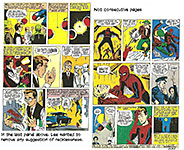
On
the last page of Part Two (shown nearby with page 3), Lee’s comment focuses on
the sixth panel. Here, he asks that Ditko “lift up” the second policeman’s
head. In the original, apparently the second cop’s head is lower down in the
panel—or perhaps just smaller. “Lifting it up” enhances its visibility, and
Ditko may have complied with the suggestion although the head remains pretty
small, so maybe he didn’t.
But
the other comment Lee made, his third instruction, Ditko ignored. On page eight
of Part Two, Lee’s penciled comment is next to the third panel: “Steve, omit
crook! Show door slamming!” Ditko quite sensibly ignored this command. 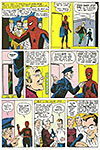
He
probably ignored it because omitting the crook would remove the visual interest
in the panel: a vertical line indicating closed elevator doors is scarcely a
dramatic picture, and the scene demands some drama, coming, as it does, at the
end of a presumably heated pursuit.
Ditko
may also have realized that the crook’s face, which establishes his identity at
the end of the story (look again at the previous visual aid), needs a little
more exposure than even the close-up of the next panel supplies. The figures of
the crook in both second and third panels are small, but the heavy eyebrows
provide a quick and certain means of identifying him. The profile in the fourth
panel confirms in detail the distinctive eyebrows, but profiles, as a general
rule, are not useful in identifying anyone except in profile; and the crook at
the end does not appear in profile.
Without
page eight’s several exposures of the crook’s face, including the detailed
profile, we might not be equipped to share Spider-Man’s moment of recognition
at the end, and the story with its heart-rending moral lesson would be
substantially spoiled. Ditko was right to ignore Lee’s dictum here.
Judging
solely from this instance—perhaps the only “documentary evidence” we have—Lee,
as editor and scripter, influenced how Ditko told the story that Lee plotted,
but Ditko did the actual storytelling, enhancing its emotional highs and lows,
and he didn’t always do what Lee wanted him to do. Ditko is clearly the better
visual storyteller; Lee’s advice here is either off the mark or almost
superfluous. (End of reprise of No.303 report, but bear it in mind when we
re-visit the question of who did what on Spider-Man.)
UNLIKE SUPERMAN
OR BATMAN (characters from Marvel’s chief rival at the time, National
Periodical Publications, which later became DC Comics), Spider-Man had
humanizing flaws. He was hounded, Webster continues, not praised, by the press
and the police. In his secret identity as Peter Parker, he was mocked by his
peers. And he struggled with guilt over his uncle’s death, which he felt he
could have prevented (as we’ve just seen), and fretted about his frail and
aging aunt.
Teen
superheroes, as Calvin Reid observes at publishersweekly.com, were usually
sidekicks to other superheroes. But “Spider-Man, along with his alter ego,
teenage prodigy and news photographer Peter Parker, was something different for
a new generation of comics fans. Wracked by teenage problems of isolation,
insecurity and social rejection, Parker lived at home in Queens, New York with
his aunt May, and seemed to always be scraping to make money. ...
“Ditko’s
drawings of Spider-Man’s high-flying antics were dynamically rendered— Spidey’s
bodily actions were anatomically precise as well as kinetic, his arms and
legs gesticulated in ways evocative of a spider’s movements— and his fight
scenes were meticulously choreographed and so cinematically rendered, the
characters seemed to move right across the page.” 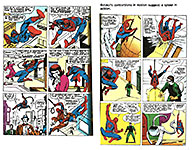
Webster
agrees: Spider-Man’s fight scenes and aerial acrobatics had a spry kineticism
that contrasted with the brawny physicality of Kirby’s compositions. Spider-Man,
unlike the thunder god Thor and other signature Kirby characters, was not
musclebound; he was a slender teenager. While Lee’s dialogue for Spider-Man
could be buoyant, peppered with wisecracks, Ditko lent mood in his pictures.
Spider-Man’s
mask, obscuring his entire face, and his web-textured costume had a slightly
morbid aspect. Spider-Man’s pensive moments — when Peter agonized over
sacrifices his alter ego had demanded of him, for example — echoed the
psychological struggles in Ditko’s earlier horror comics.
Ditko
also helped conceive famous villains, Webster goes on, like the Green Goblin
and Dr. Octopus, and supporting characters.
STEPHEN DITKO
WAS BORN on November 2, 1927, in Johnstown, Pa. His father, also Stephen, was a
steel-mill carpenter; his mother, Anna, was a homemaker. His father bequeathed
to his son a love of newspaper strips like Hal Foster’s Prince Valiant, and the young Stephen devoured Batman and Will Eisner’s noirish Sunday
newspaper insert, The Spirit.
Young
Steve was an only child for his first seven years, Dean notes, “but was
eventually joined by two brothers and two sisters. In high school, he was a
member of the science club and a club devoted to carving model planes to aid in
the training of enemy-plane spotters. Upon graduating in 1945, he did a stint
in the Army, during which he was stationed in postwar Germany, drawing cartoons
for the military newspaper. During this time, he produced a monthly comic book
and mailed it to an audience of one: his brother Pat.
“After
returning to civilian life, Ditko enrolled in New York’s Cartoonists and
Illustrators School (today known as the School of Visual Arts), where he
studied under Batman artist Jerry Robinson. One of his classmates was
future bondage cartoonist and photographer Eric Stanton, with whom Ditko
would share a studio from 1958 to 1968.”
Robinson
said he was impressed by Ditko: “He put in the hard work and tried to
participate in our discussions on anatomy, perspective, drapery—you name it.
Steve was very creative and a very good craftsman. I think I might have had
something to do with influencing his storytelling because that’s what I
emphasized in my class. I tried to teach the students how to think about the
comic, what they wanted to do with it, and that drawing was the tool. I think I
made him a good storyteller. He showed so much promise I recommended him for a
second year. He was in my class for two years, four or five days a week, five
hours a night. It was very intense.”
Ditko’s
first work in print was in early 1953, said Webster, in a romance comic from a
minor publisher. 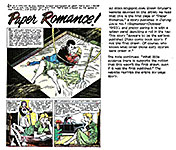 For three months he worked in the studio of Kirby and Joe Simon, the creators
of Captain America, before heading to Charlton Comics, which had its
headquarters in Derby, Connecticut. Charlton offered low pay and inferior
production values but creative freedom, and Ditko would return there often over
his career. During his first tour there, he would create 170 pages and 19 covers
in less than a year, despite suffering from the onset of tuberculosis, which
would sideline him for a year beginning in 1954. For three months he worked in the studio of Kirby and Joe Simon, the creators
of Captain America, before heading to Charlton Comics, which had its
headquarters in Derby, Connecticut. Charlton offered low pay and inferior
production values but creative freedom, and Ditko would return there often over
his career. During his first tour there, he would create 170 pages and 19 covers
in less than a year, despite suffering from the onset of tuberculosis, which
would sideline him for a year beginning in 1954.
The
introduction of the Comics Code Authority — a regulating body established by
the industry in 1954 in response to Senate subcommittee hearings into the
supposed influence of comics on juvenile delinquency — stifled Ditko’s Charlton
output, which had largely covered horror, crime and science fiction.
Influenced
by the artist Mort Meskin, a specialist in mood and noirish textures,
Ditko had infused his pre-Charlton work with a sweaty anxiety and recurrent
motifs of paranoia. 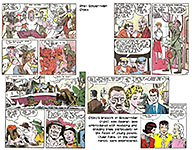 In “In Search of Steve Ditko” — a 2007 British documentary narrated by
the TV personality Jonathan Ross — the novelist and comic book writer Alan
Moore says that in Ditko’s work there was “a tormented elegance to the way
the characters stood, the way that they bent their hands.” In “In Search of Steve Ditko” — a 2007 British documentary narrated by
the TV personality Jonathan Ross — the novelist and comic book writer Alan
Moore says that in Ditko’s work there was “a tormented elegance to the way
the characters stood, the way that they bent their hands.”
He
added, “They always looked as if they were on the edge of some kind of
revelation or breakdown.”
In
1954, tuberculosis forced Ditko back to Pennsylvania, where he nearly died.
After a year, he returned to New York, where he approached Lee, at the time a
writer-editor for Atlas Comics, a precursor to Marvel.
Lee,
impressed with Ditko’s speed and proficiency, hired him. Atlas’s horror line,
emasculated by the code, became largely divided between Kirby’s stories,
starring generic monsters with names like Groot and Fin Fang Foom, and Ditko’s
agonized character studies.
Cutbacks
at Atlas brought Ditko back to Charlton, where he and the writer Joe Gill
created the nuclear-powered Captain Atom, before returning to what was now the
Marvel Comics Group. Marvel was in a rebirth, starting with the publication of
the Fantastic Four in 1961, and continuing with Thor and the Hulk.
Spider-Man
debuted in 1962. Kirby drew the cover of his debut, but for three years the
character was Ditko’s baby. 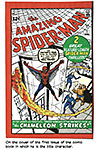
Ditko
helped develop other Marvel superheroes, including Iron Man and the Hulk. Of
these, probably his best-known, besides Spider-Man, was Dr. Strange, a “master
of the mystic arts,” who first appeared in 1963 in Strange Tales No.110. Even Lee conceded that Dr. Strange was Ditko’s creation: “Twas Steve’s
idea,” he once said.
For
Dr. Strange’s occult adventures and battles in alternate dimensions, Ditko
created foreboding expanses of abstract shapes and patterns, ruled by evil
sorcerers and supernatural entities. “Strange is as straight-faced a hero as
they come,” says Dean, “but ... Lee’s goofy necromantic wordplay (the Eye of
Agamotto, the Seven Bands of Cyttorak) keep things from become too dour.”
Ditko
continued with Dr. Strange for 36 issues, ending in July 1966.
But
it was with Spider-Man that Ditko flourished.
MARVEL ARTISTS
GENERALLY FOLLOWED the “Marvel method,” said Webster, in which artists built on
Lee’s synopses and were encouraged to emulate Kirby’s outsize style. Lee
would provide a plot outline (sometimes little more than a speculative
hint—what would happen if...?), and the artists would expand upon the idea,
turning it into a visual narrative, to which, later, Lee would add dialogue and
captions). It was a method that left open to debate which of the collaborators
“created” the story. And the character. Ditko, who focused less on fight
scenes and more on Peter Parker’s psyche, thus had broad license with plotting
and drawing The Amazing Spider-Man. Many fans regard Issues 31, 32 and
33 — which climax with the superhero, after reviewing his life, triumphantly
upending heavy machinery that has pinned him — as a Ditko peak.
The
first 38 issues of The Amazing Spider-Man proved to be Ditko’s most
enduring success, says Dean, continuing—:
Even
today, Spider-Man movies and comics are still trying to find their way back to
the combination of elements that Ditko instilled in the series: the youthful
exhilaration and aerial ballet of Peter Parker giving vent to his web-swinging
powers, the down-to-earth subjective point of view of a troubled adolescent,
the smoothly paced storytelling.
How
much of the character can be attributed to Ditko and how much to Lee has been
the subject of endless debate. Even Jack Kirby had a claim, having drawn the
first cover and an earlier unused Spider-Man character design and partial story
at Lee’s direction. But it was undeniably Ditko who established the look and
feel of the series as it was published. The Marvel Method gave him considerable
leeway to develop characters and storylines, and this was especially true as
Lee gradually abandoned his pre-penciling story conferences with Ditko.
When
Lee later referred to himself in interviews as Spider-Man’s creator, Ditko
objected. In Sean Howe’s Marvel Comics: The Untold Story, Lee recounted
a conversation in which Ditko told him, “Having an idea is nothing because
until it becomes a physical thing, it’s just an idea.’”
Lee
responded by arguing that “the person who has the idea is the person who
creates it.” Unless you believe that what made the first Spider-Man comics
great was that they were about a kid who gets bitten by a radioactive spider
and gains arachnid powers, then Ditko’s point seems valid. We readers didn’t
fall in love with a synopsis; we were captivated by the way Lee and Ditko
brought the idea to life.
Ditko’s
work on Spider-Man with Lee was less a collaboration than a dialectical
collision.
According to Marvel writer/editor Roy Thomas, Lee and Ditko disagreed on
just about everything, from aesthetics to politics. But it was a collision that
made possible a uniquely affecting comic book. Lee conceived the teenage,
high-school milieu but Ditko protected that world from Lee’s more fanciful,
cosmic ideas, arguing that Spidey’s villains should be rooted in the streets of
New York. The Amazing Spider-Man combined Ditko’s story pacing,
character design and wiry movements with Lee’s self-aware dialogue, Ditko’s
interiorized existential dilemmas with Lee’s trademark tension between the
ordinary and the extraordinary.
Years
later, in 1999, Lee issued an open letter to the press stating: “I have always
considered Steve Ditko to be Spider-Man’s co-creator. … I write this to ensure
that Steve Ditko receives the credit to which he is most justly entitled.”
Ditko,
in a 2002 essay printed in his Avenging World collection, dismissed the
gesture, drawing a distinction between considering Ditko to be
Spider-Man’s co-creator and avowing that Ditko is Spider-Man’s
co-creator.
On
the face of it, Ditko’s position seems to be absurdly contrarian. But maybe
Ditko understood that Lee made the statement not so much because he believed
Ditko was co-creator, but because, as he said in Marvel Comics: The Untold
Story, “Steve definitely felt that he was the co-creator of Spider-Man. …
So I said fine, I’ll tell everybody you’re the co-creator.”
DITKO’S
CONCEPTION of the series, says Webster, had been shifting, increasingly
influenced by Ayn Rand’s libertarian philosophy. Spider-Man’s villain the
Looter was named after Rand’s term for those leeching from the creative elite,
phrases like “equal value trade” crept into Parker’s words, and he voiced
resentment toward student protesters. (Lee, in speaking engagements on college
campuses, found himself in the awkward position of having to explain to irate
young audiences that such a stance was Ditko’s, not his own, as Ditko did
more and more of the Spider-Man stories, dialoging as well as drawing.)
Ditko
bristled at being denied royalties when Spider-Man had his own animated ABC
television series and was used in product tie-ins. He left Marvel in 1965 (Spider-Man No. 38 was his final issue) and worked for other publishers
before returning to Charlton.
Andy
Lewis at hollywoodreporter.com speculates that Ditko left Marvel “over a fight
with Lee, the causes of which have always remained murky. The pair had not been
on speaking terms for several years. Ditko never explained his side, and Lee
claimed not to really know what motivated Ditko's exit.
“The
best explanation suggests Ditko was frustrated at Lee's oversight and his
failure to properly share credit for Ditko's contributions to Spider-Man and
Doctor Strange. The charismatic Lee was always the face of Marvel Comics, but
Ditko (and Jack Kirby) thought Lee was more interested in self-promotion than
selling the company, and, in the process, implied that he deserved the lion's
share of the credit for creating the characters in the Marvel Universe.”
Dean
allows that there are “theories galore in the comics community” about why Ditko
left. “Some say Ditko’s new objectivist philosophy clashed one too many times
with the parameters of the Marvel universe. Certainly, Lee and Ditko had ceased
to work together. Ditko constructed his stories visually and Lee interpreted
them verbally, with neither creator consulting the other. The conflicts
reportedly stemmed from Ditko’s relationship with Goodman, who Ditko felt, owed
him merchandising royalties. The problems between Lee and Ditko might be
attributable to the fact that each served a different master, Lee obliged to
carry out Goodman’s directives and Ditko loyal to Rand and her view of the
world.”
Ditko
pursued Randian notions further, said Webster, picking up the narrative—
particularly with Mr. A, a character he
created for Wood’s witzend, a
black-and-white comic aimed at adults and unconstrained by the Comics Code. Mr.
A, attired in a white suit and conservative hat, was named after “A is A,” the
idea in Rand’s Atlas Shrugged that there is one unassailable truth, one
reality, and only white (good) and black (evil) forces in society. Unlike
mainstream superheroes, he killed criminals.
.
Back
at Charlton, Ditko created The Question, also in a suit and hat but devoid of
facial features. Like Mr. A, The Question spoke in a stilted, didactic
vernacular akin to a philosophical tract’s. (Like Captain Atom, The Question is
now owned by DC.) In 1968, Ditko said in a rare interview that The Question and
Mr. A were his favorite creations.
At
Charlton, Ditko also created Blue Beetle, reported Graeme McMillan at
hollywoodreporter.com — another insect-themed character, who in many ways
mirrored a more straight-laced, less neurotic Spider-Man — as well as The
Question and Captain Atom, all three characters who were literally ahead of
their time; all three would become successful under different writers and
artists when revived for critically-acclaimed runs at DC, while simultaneously
inspiring Nite Owl, Rorschach and Doctor Manhattan in Alan Moore and Dave
Gibbons’ Watchmen. According to Dean, Ditko refused to work on any
story that featured supernatural elements, citing objectivist principles.
For
DC itself, which Ditko joined in 1968, he created a panoply of newcomers, from
Hawk and Dove — two ideologically-opposed brothers granted powers by a
mysterious mystical force who had to work together to save the day — to Shade
the Changing Man, a former secret agent whose M-Vest allowed him to reshape
reality itself even as the political landscape around him shifted in an
ever-more-paranoid series. Another DC creation was the Creeper, a reporter crime-fighter
with a maniacal laugh whose secret identity allowed him to fight injustice
and untruth in a far more direct manner than simply writing newsstories.
Another
bout with tuberculosis derailed those series, and both Shade and the Creeper
ended within a year.
DITKO’S
AVERSION TO ATTENDING COMIC CONVENTIONS and meeting fans was well known. Early
unauthorized reproductions of his work in fanzines angered him, as did the
failure by some fanzine publishers to return originals he had lent them. By
1964 Ditko had withdrawn from the public eye, limiting exchanges to mail or
telephone. His reclusiveness, and his Randian ideas, lent his work a patina of
mystery.
The
1970s and ’80s proved comparatively fallow. Ditko’s output plummeted,
especially after Charlton’s demise in 1978. In the 1980s, there were more
stints at Marvel and DC and at the independent publisher Eclipse. However, in
1991, Ditko co-created Squirrel Girl for Marvel, who remains a fan favorite.
Even
as he receded into quasi-retirement — he never fully retired; as recently as
2016, he was still producing work that was, to all intents and purposes,
self-published with editor and friend Robin Snyder — he continued to
freelance and create new characters, according to McMillan. He returned to
Marvel to co-create Speedball and Squirrel Girl, the latter now one of the
company’s biggest successes outside of the fanboy-centric direct market. At
other publishers, he came up with Missing Man, the Mocker, Static and,
reflecting his own political views, the objectivist Mr. A.
The
one throughline that all these characters had, in addition to Ditko’s trademark
aesthetic that focused on eyes and hands to an almost fetishistic degree at
times, was that all of them were… strange. (No pun intended, McMillan adds.)
Ditko’s characters were always a little outside of the mainstream, a
celebration of the individual and the outsider even at a time when such things
were rare and superheroes traditionally aspired to be agents of the status quo.
Ditko’s creations, even those theoretically intended to be family-friendly like
Speedball and Squirrel Girl, were always just a little creepy and weird...
which is the very thing that made them memorable, and even lovable.
Throughout
the decades he worked and introduced new ideas and new characters into the
world, Ditko defied trends and followed his own off-kilter muse; he was an
auteur at a time when few existed in comics, and everyone and everything he
worked on demonstrated that. As McMillan wrote above, he was a creator ahead of
his time in terms of ideas — even Squirrel Girl took two decades from creation
to become a success, an oddly similar gap to that between the debut and
commercial peak of his Charlton characters — but also in terms of attitude.
McMillan
concludes: “Without meaning to (because his interest was always merely to do
his own thing; he was an objectivist, after all), Ditko demonstrated the value
of following your own creative impulse years before Image Comics or the
landscape surrounding it existed; without knowing it, he pointed to the future.
Comics is a lesser place without him. “
In
later years, Webster continues, Ditko created black-and-white digest-size
comics financed with Kickstarter funds and sold online. These self-published
titles, ad-free and often edited by Snyder, bore a scratchy, sometimes
pointillistic style and Randian preoccupations: rationality, “looters,”
“earners.” 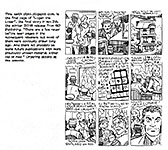
In
editor/writer Snyder, Dean says, Ditko found what may have been his closest and
most enduring relationship since his studio-sharing days with Eric Stanton. Their
professional connection went back to 1983, when Snyder edited Ditko’s work on
Archie Red Circle titles like The Fly and The Mighty Crusaders.
In 1985, when Ditko left Eclipse for Charlton, Snyder again edited Ditko’s
stories in Charlton Action featuring Static. And after Charlton shut its
doors for good, Snyder oversaw Ditko’s transition to Renegade Press, working
with the artist on titles like Revolver, Murder and Static.
Their
rapport was great enough that when Renegade suspended publication in 1988,
Snyder and Ditko decided to self-publish a black-and-white collection of
Ditko’s Static stories. This was followed in 1989 and 1990 by more cheap,
black-and-white trade paperbacks mixing repackaged reprints with new material,
including The Ditko Public Service Package, a 112-page slash-and-burn
commentary on the comics industry mostly in comics form. And when mainstream
venues finally dried up for Ditko at the end of the century, these
Ditko/Snyder- published collections were the format he returned to.
UNTIL HIS
DEATH, DITKO MAINTAINED a writing studio in Manhattan, where he continued to
write and draw, though how much, and what unpublished material remains, is
unknown. He continued to be incredibly reclusive, turning down nearly all
offers to do interviews, meet fans or appear at movie premieres, reported
Lewis.
"We
didn't approach him," Scott Derrickson, director of the 2016 movie
"Doctor Strange," told Lewis. "He is private and has
intentionally stayed out of the spotlight. I hope he goes to see the movie
wherever he is, because I think we paid homage to his work."
Lewis
said comic book creator Graig Weich of BeyondComics.TV struck up a friendship
with Ditko over the last year of his life and would visit him in his Manhattan
office, where he'd find the legendary creator well-dressed and sporting a
beret, as though he had stepped out of the 1940s. Ditko continued to work on
his own creations, though he didn't share the details of them with Weich, who
recalls Ditko seeming younger than his years.
"He
wasn't 90. He seemed like a young, cool artist who happened to have an aged
body," Weich tells The Hollywood Reporter. Weich recalls asking
Ditko about his relationship with Lee, and says the artist looked down and told
him, "We're peaceful."
Weich
learned of Ditko's death when he went to visit him Friday, and the security
guard informed him of the artist's passing. The security guard also told him
that Weich was one of the few people over the past four years the artist had
allowed up into his office.
Dean
takes up the question about Ditko’s relationship with Eric Stanton, with
whom he shared a studio during his time at Marvel. He often provided inking for
Stanton’s bondage-themed, under-the-counter comics (Sweeter Gwen,
Confidential TV). Stanton told Eric Kroll (in The Art of Eric Stanton) that he would also occasionally assist on Ditko’s Spider-Man work, but denied
having any significant impact on the Marvel character.
For
his part, Dean goes on, Ditko never acknowledged doing any work on Stanton’s
comics. When asked about Stanton by Loubert and others, Ditko would shut the
conversation down.
Which
brings Dean to the final question: why did Ditko, the self-made objectivist,
who was so immune to the mores of the masses, balk at owning up to his
contributions to a few kinky comics pages? It’s a question that touches on what
may be the biggest void in public accounts of his life. Dean’s answers—:
There
is no indication that Ditko was ever intimately involved with another human
being. No marriages. No romantic flings. (A report by Will Eisner that
he had met Ditko’s “son,” was never corroborated and Eisner is generally
presumed to have mistaken Ditko’s nephew for a son.) His compulsion to sweep
his sexually themed work with Stanton under the rug may suggest a reticence
about such intimate matters. Or it may just stem from the severely
honor-bound Ditko’s determination to be discreet about his ghost work for
another artist. There was, after all, very little that Ditko wasn’t happy to
sweep under the rug.
Only
one of the accounts of Ditko’s life offered information about survivors: Ellis
Clopton says the artist is survived by a nephew.
Webster
concludes his report—:
Ditko
was inducted into the Jack Kirby Hall of Fame in 1990 and the Will Eisner Hall
of Fame in 1994. In Sam Raimi’s Hollywood feature “Spider-Man,” in 2002, the
opening credits read, “Based on the Marvel comic book by Stan Lee and Steve
Ditko.” The 2008-9 ABC animated series “The Spectacular Spider-Man” gave
similar credit.
In
2016, the Casal Solleric museum in Mallorca, Spain, presented a retrospective
of his work, “Ditko Unleashed.” That same year, Marvel Studios released the hit
film adaptation “Doctor Strange”; an opening credit read, “Based on the
characters created by Steve Ditko.”
Ditko
avoided his fans to the end. In 2014, Dan Greenfield, a writer for the website
13th Dimension, recounted reaching Ditko’s Manhattan apartment doorway in an
attempt to interview him. Ditko did not bite.
Celebrities
had slightly better luck. In the television documentary, Jonathan Ross,
accompanied by the writer Neil Gaiman, visits the Manhattan building housing
Ditko’s studio, hoping for a meeting. The two briefly receive an audience. But
on camera? Not a chance.
We
conclude with a few more of Ditko’s pictures.
Return to Harv's Hindsights |